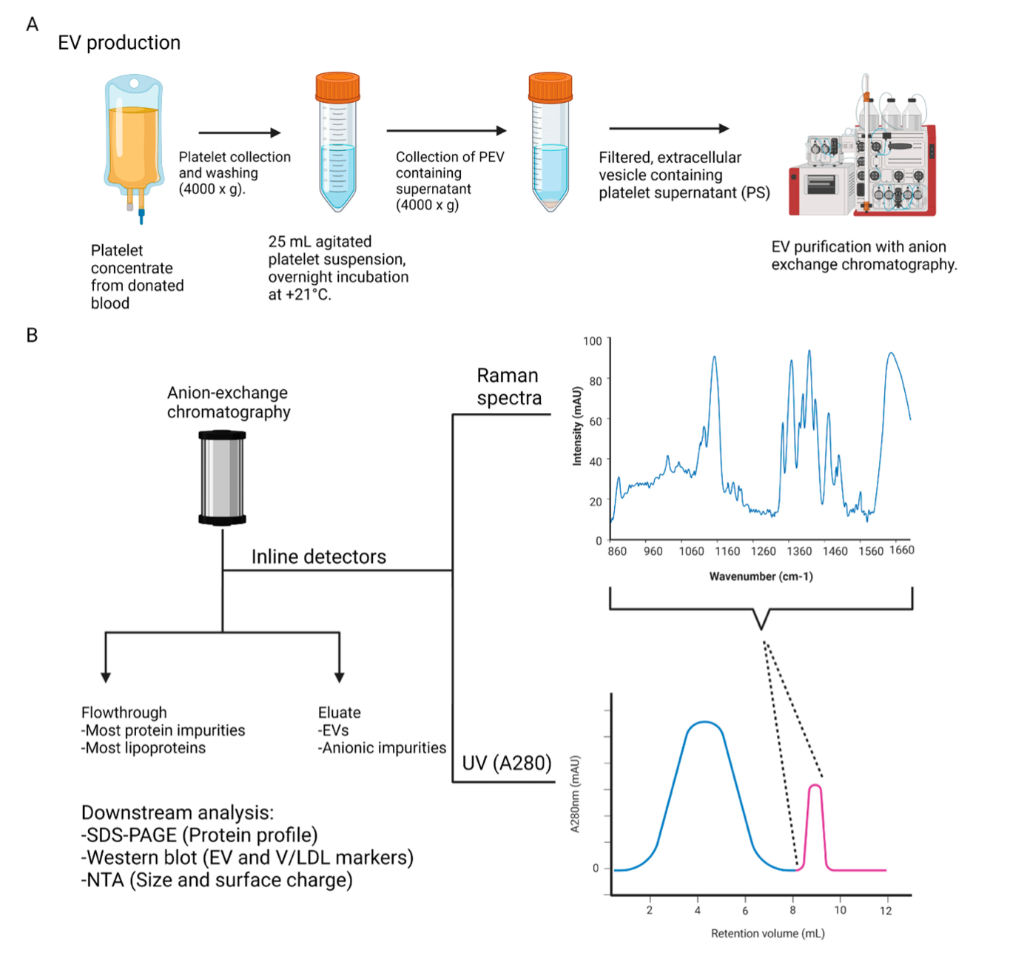16-Apr-2025
The article "Inline Raman Spectroscopy Provides Versatile Molecular Monitoring for Platelet Extracellular Vesicle Purification with Anion-Exchange Chromatography" explores the use of inline Raman spectroscopy as a real-time analytical tool for monitoring the purification of extracellular vesicles (EVs) derived from human platelets.
EVs are promising as potential carriers of therapeutic agents, but large-scale production requires efficient and reproducible purification techniques. Researchers in Helsinki aimed to improve and streamline the purification and real-time monitoring of EVs derived from human platelets and overcome challenges in EV isolation, characterisation, and scalability for standard research and therapeutic applications. The project received funding from the Instruct-ERIC R&D Scheme, and was carried out in collaboration with several institutions in Finland.
Heikki Saari, lead researcher on the project, said: “As a part of its function, the Finnish Red Cross, Blood Service is constantly seeking to improve their blood donation and blood processing, as well as developing new products from blood. Blood cell EVs have become one of our main research and commercial interests, and we seek to produce them using mainly ion exchange chromatography. We started this project together with Timegate instruments Inc., who develop Raman detectors, since Raman spectroscopy can provide detailed information about the composition of complex biological structures, such as EVs. Process monitoring is still an understudied aspect of EV production and we wanted to address it with this project, since better monitoring methods are critical for producing EVs in large scale.”
The study combined anion-exchange chromatography (AEC) with Raman spectroscopy to isolate, track, and characterise platelet-derived EVs while effectively removing impurities such as low- and very-low-density lipoproteins (V/LDL). Blood-derived EVs are often contaminated with V/LDL due to their similar size and UV absorbance (A280) alone cannot differentiate EVs from other protein-based contaminants. Traditional methods like Western blotting, nanoparticle tracking analysis are usually performed after isolation, requiring additional time and effort. The use of Inline Raman spectroscopy enabled real-time monitoring, distinguishing different molecular components during purification. Researchers were able to use AEC to successfully isolate EVs from platelet supernatant while removing free proteins and lipoproteins. This showed that Inline Raman spectroscopy provides a non-destructive, real-time method for analysing EV composition and purity, reducing the need for labour-intensive post-isolation analyses such as Western blotting or nanoparticle tracking analysis.

Figure 1. Purification and purity assessment of platelet-derived EVs. This approach combines chromatographic separation with spectroscopic analysis to ensure effective isolation and characterisation of EVs.
- (A) Isolation of EVs from donated platelets. Platelets undergo washing, collection, and activation via agitation, followed by overnight EV secretion in platelet supernatant (PS). Purification is achieved using fast protein liquid chromatography with a monolithic anion exchanger.
- (B) Multi-modal monitoring of the purification process. Chromatography system's built-in detector measures absorbance at 280 nm and subsequent inline Raman spectroscopy measures Raman spectra at set intervals. Flowthrough and eluate fractions are analysed for protein content, nanoparticle characteristics, and EV markers.
Unexpectedly, carotenoids were detected in platelet-derived EVs. Normally, lipoprotein particles are considered as the primary carriers of carotenoids in the blood, but platelets have also been found to contain carotenoids. While the discovery of carotenoids in platelet-derived EVs challenges existing models of EV composition it makes sense that platelet secreted EVs would also contain the same carotenoids. However, their biological significance has not been clarified yet and this finding could lead to further studies on their functional role.
Heikki Saari continued: “During our project we used the facilities of the Biocomplex purification unit and Cryo-EM unit at the University of Helsinki, which are part of the Instruct-ERIC infrastructure. The Biocomplex purification unit provided us with the ultracentrifuges and liquid chromatography system with anion exchange column and allowed us to add our own detector to the system for our experiments, and the purified EVs were visualized with the help of the Cryo-EM unit. We are grateful for being able to work with both groups, as this project would not have gone as smoothly as it did without their help and expertise.”
This research presents a scalable, real-time, and label-free approach to EV purification, addressing key challenges in EV manufacturing and quality control. The use of inline Raman spectroscopy in this way could revolutionise structural and molecular biology techniques, making EV-based therapeutics and diagnostics more efficient and reliable. This method offers an alternative to traditional characterisation methods and a possible future standard for EV isolation from a variety of sample types and replace ultracentrifugation. Additionally, Raman spectroscopy can complement or even replace techniques such as UV absorbance or fluorescence tagging, which are less specific for EV analysis.